Categories > Guides and Tips

Ultimate Guide to Buddhism in Thailand
- Thai Buddhism is based on the Theravada school
- Buddhism is the primary religion in Thailand
- Thai Buddhism has influenced art, literature, and dance
- Monks play a central role in Thai Buddhism
- Meditation is emphasised in Thai Buddhist practice
- Merit-making is an important aspect of Thai Buddhism
- Thai Buddhist festivals include Songkran and Loy Krathong
- Thai Buddhism follows the Four Noble Truths
- Thai Buddhism incorporates animism and folk beliefs
- Thai Buddhism promotes a balanced approach to life
Buddhism, with its rich history and profound teachings, has long been an integral part of Thai culture and society. As the predominant religion in Thailand, Buddhism holds a special place in the hearts and minds of its people.
In this comprehensive guide, we will uncover an array of captivating facts that shed light on the essence of Thai Buddhism.
Thai Buddhism is based on the Theravada school
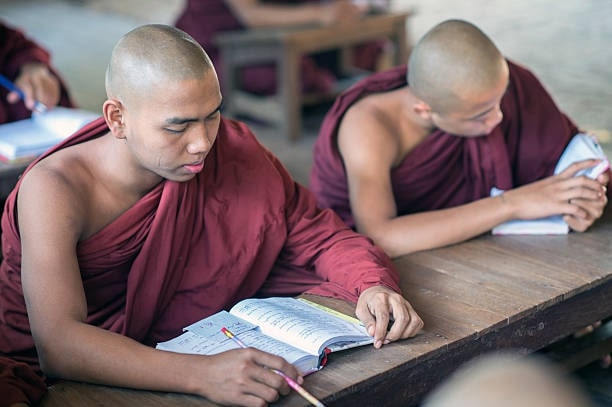
When it comes to Thai Buddhism, you’ll find that it is rooted in the Theravada school of Buddhism. This particular branch emphasises the teachings of the Pali Canon, which are considered the earliest recorded scriptures of Buddhism.
The Theravada tradition places great importance on self-discipline, meditation, and the pursuit of personal enlightenment. So, if you’re curious about the foundations of Thai Buddhism, you’ll find that the Theravada school forms its bedrock.
Local tips:
- Visit Wat Phra Kaew and Wat Arun in Bangkok to experience the grandeur of Theravada Buddhist architecture.
- Engage in discussions with knowledgeable locals or Buddhist scholars to gain insights into the specific teachings and practices of Theravada Buddhism in Thailand.
Buddhism is the primary religion in Thailand
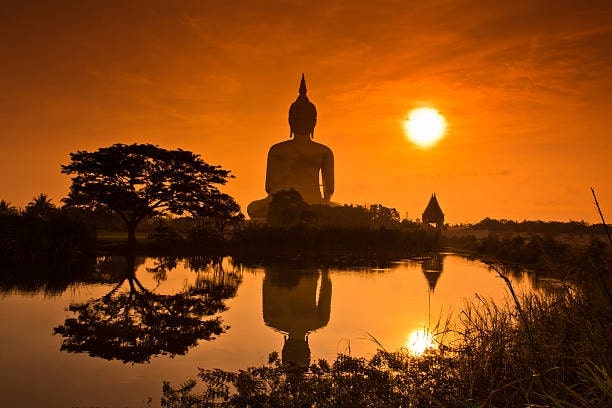
If you ever find yourself in the Land of Smiles, you’ll quickly notice that Buddhism holds a special place in Thai society. In fact, it is the primary religion in Thailand, with over 90% of the population identifying as Buddhists.
Buddhism’s influence is evident in various aspects of daily life, from the presence of temples on every street corner to the sight of saffron-robed monks walking the streets for alms.
Local tip: Attend Buddhist ceremonies and observe the devotion and practices of local worshippers to deepen your understanding of the religion.
Thai Buddhism has influenced art, literature, and dance
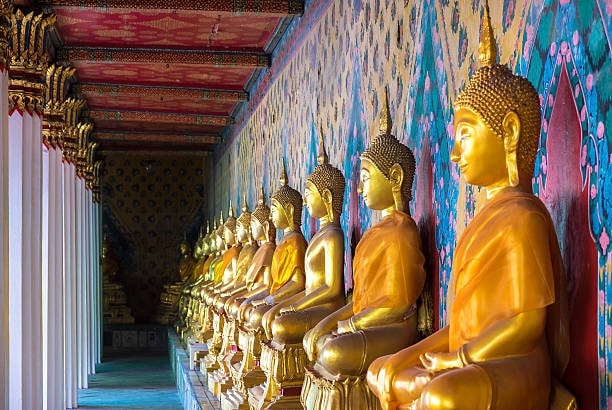
Image source: iStock
The influence of Thai Buddhism extends far beyond temples and meditation. It has permeated various forms of artistic expression in Thailand.
Thai Buddhist art is renowned for its beauty and symbolism — from intricate murals in temples to delicate sculptures.
Literature, too, reflects Buddhist principles, with many Thai literary works exploring themes of karma, rebirth, and the pursuit of enlightenment.
Additionally, traditional Thai dance often incorporates elements of Buddhist stories and teachings, bringing them to life through graceful movements and vibrant costumes.
Local tip: Visit museums and art galleries showcasing Buddhist art to appreciate the intricate details and symbolism behind the artwork.
You can also engage in workshops or classes to learn traditional art techniques, such as painting or sculpture, inspired by Buddhist traditions.
Monks play a central role in Thai Buddhism
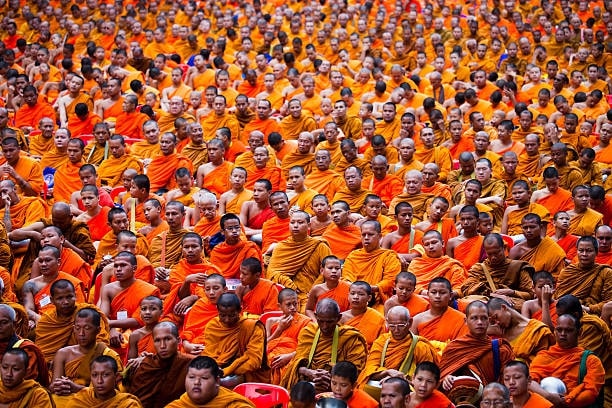
Monks are not just a symbol of Thai Buddhism; they are at the heart of the religion. These revered individuals follow a disciplined and ascetic lifestyle dedicated to the pursuit of enlightenment.
You’ll often see them clad in saffron robes, with shaved heads, and carrying alms bowls as they walk the streets each morning to receive offerings from the community.
Monks play a pivotal role in preserving and disseminating Buddhist teachings, and they are highly respected members of Thai society.
If you have the chance to interact with monks, you’ll gain valuable insights into their way of life and the profound wisdom they embody.
Local tip: Visit local temples during morning alms rounds to witness the interaction between monks and the community.
Meditation is emphasised in Thai Buddhist practice
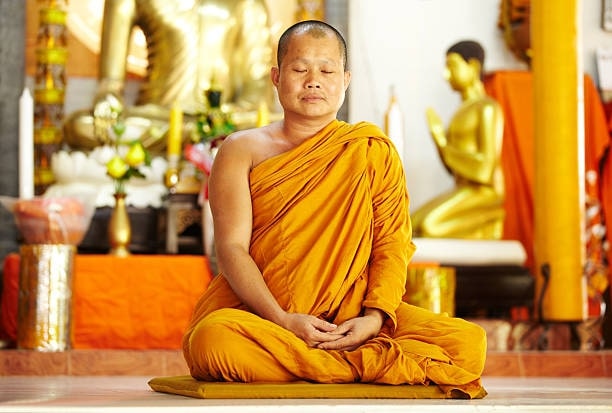
When it comes to Thai Buddhism, meditation takes centre stage. Meditation, known as bhavana, is seen as a means to cultivate mindfulness, develop concentration, and gain insight into the nature of reality.
Thai Buddhist practitioners often engage in both Vipassana meditation, which focuses on mindfulness and insight, and Samatha meditation, which aims to cultivate calmness and concentration.
Whether it’s at a quiet temple retreat or a bustling urban meditation centre, you’ll find opportunities to explore and experience the transformative power of meditation in Thailand.
Local tips:
- Seek out meditation centres or temples offering meditation classes or retreats to learn different meditation techniques.
- Participate in meditation retreats led by monks to learn meditation techniques and gain guidance on mindfulness practice.
Merit-making is an important aspect of Thai Buddhism
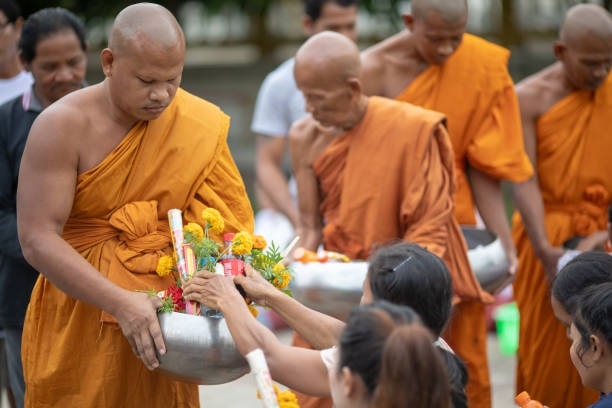
In Thai Buddhism, the concept of merit-making holds significant value. It involves performing acts of kindness, generosity, and virtuous deeds to accumulate merit, known as tham bun.
Thai people believe that by engaging in merit-making activities, they can improve their current lives and future existences. Making donations to temples, offering food to monks, and participating in charitable acts are common ways to generate merit.
This practice not only benefits individuals on a spiritual level but also contributes to the well-being of the community as a whole.
Local tips:
- Participate in acts of merit by making donations to temples, charitable organisations, or supporting social causes in Thailand.
- Join local communities in performing merit-making rituals, such as releasing animals or offering food to monks during ceremonies.
Thai Buddhist festivals include Songkran and Loy Krathong
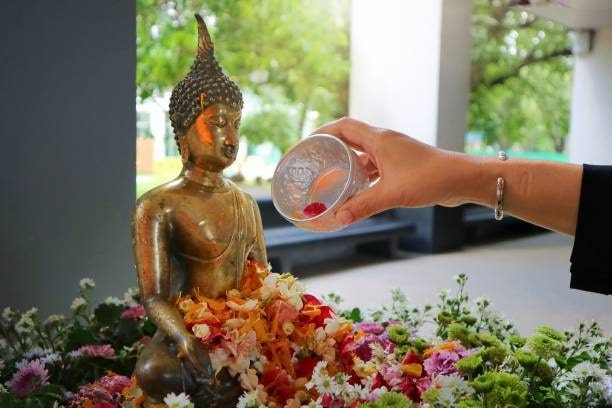
Thai festivals provide a vibrant and joyous celebration of Buddhist traditions.
Songkran, the Thai New Year, is one of the most famous festivals, known for its water fights and playful dousing of water on each other as a symbol of cleansing and renewal.
Loy Krathong, another significant festival, involves floating small lotus-shaped vessels, called krathongs, on rivers and waterways.
This act symbolises letting go of negative emotions and paying respects to the water goddess.
These festivals, along with others such as Makha Bucha and Visakha Bucha, bring communities together to express their devotion, celebrate Buddhist principles, and foster a sense of unity.
Local tips: Plan your visit to coincide with major Buddhist festivals like Songkran and Loy Krathong to witness the vibrant celebrations and cultural traditions.
Thai Buddhism follows the Four Noble Truths
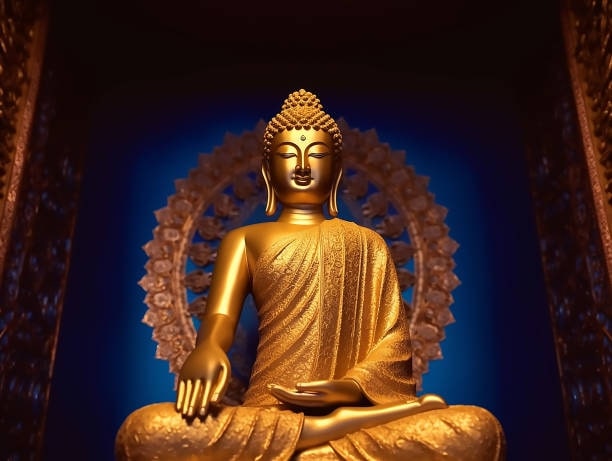
At the core of Thai Buddhism lies the Four Noble Truths, which form the foundation of Buddhist teachings.
These truths explain the nature of suffering (dukkha), its origin (samudaya), the cessation of suffering (nirodha), and the path leading to the cessation of suffering (magga).
Thai Buddhists contemplate and reflect upon these truths, striving to develop insight into the impermanent and interconnected nature of existence.
The Four Noble Truths provide a framework for understanding the human condition and serve as a guide for leading a compassionate and mindful life.
Local tips:
- Explore Buddhist teachings on the Four Noble Truths through books, online resources, or discussions with knowledgeable locals.
- Attend Dhamma talks or lectures by experienced teachers to gain further guidance and insights into the Four Noble Truths and their practical applications.
Thai Buddhism incorporates animism and folk beliefs
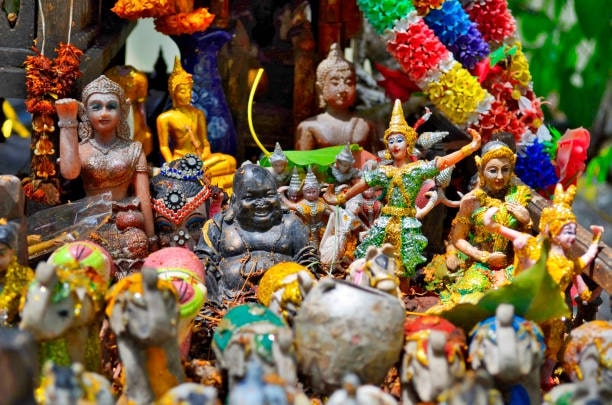
Thai Buddhism has seamlessly integrated with pre-existing animistic and folk beliefs, creating a unique blend of spiritual practices. Elements of animism, which involve reverence for natural spirits and deities, are still prevalent in Thai culture.
Many Thai people incorporate rituals and offerings to these spirits alongside their Buddhist practices.
Folk beliefs, such as amulet worship and spirit houses, also coexist with Buddhism. This syncretic approach demonstrates the adaptability of Thai Buddhism and the harmonious coexistence of multiple belief systems within Thai society.
Local tip: Explore local folk traditions and rituals that blend animism and Buddhism, such as spirit processions or village festivals, to experience the richness of this syncretic approach.
Thai Buddhism promotes a balanced approach to life
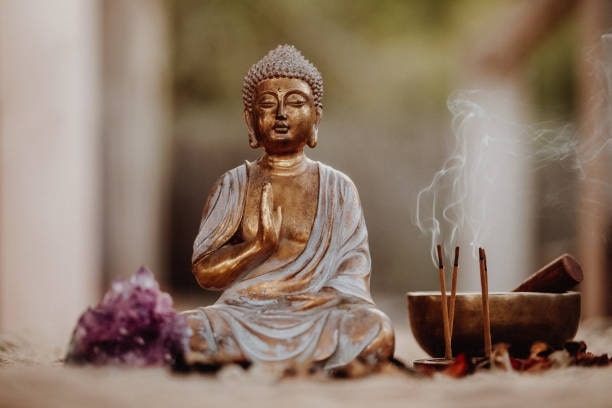
Thai Buddhism promotes a balanced approach to life, advocating for the Middle Path between extremes. It encourages individuals to find a moderate path, avoiding excessive indulgence and extreme asceticism.
This balanced approach extends to material pursuits, self-care, compassion for others, and the integration of worldly responsibilities with spiritual practice.
By cultivating mindfulness, compassion, and wisdom, Thai Buddhism offers a practical and holistic path to lead a meaningful and harmonious life.
Local tip: Engage in activities that nourish both the body and mind, such as regular meditation, physical exercise, and engaging in acts of kindness.





